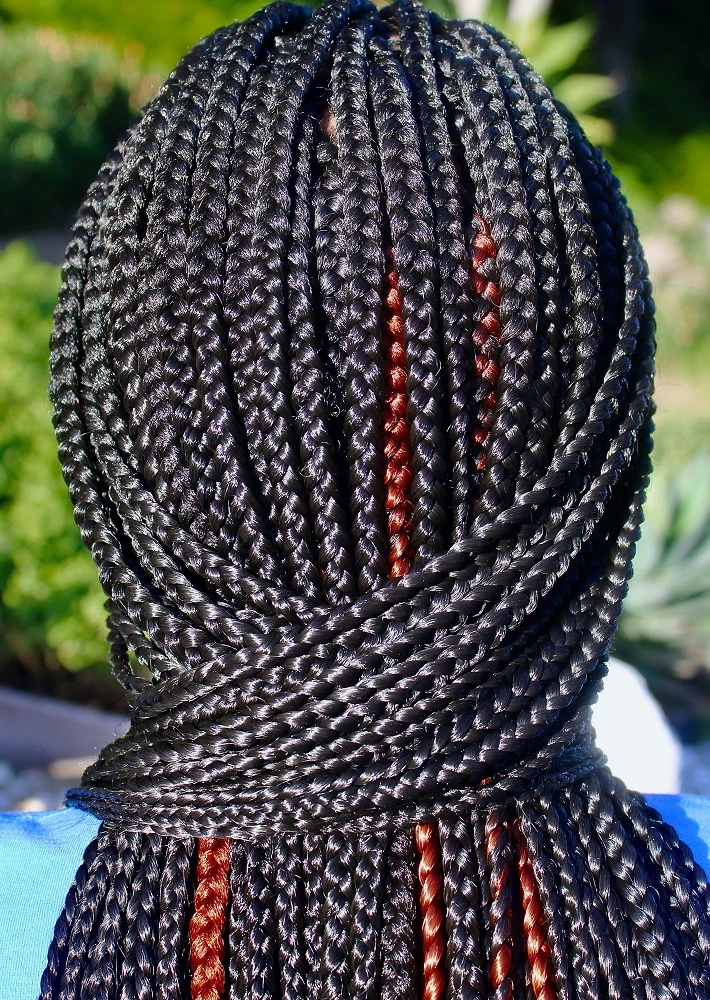I was very excited when I first found out about Peekaboo braids and saw them trending so hard.
These were one of my favorite ways to install braids, and I was calling them “braids with surprises”, before learning the official name. I wasn’t so far from the name they got, right?
If you’re not sure, stay with me here, because in this article I’m going to tell you everything about Peekaboo braids, and I hope you will start to love them as I do.
What are Peekaboo Braids?

Peekaboo Braids are all about color. They can be any type of single braids (box braids, knotless braids, even twists), or even some cornrows, but they have a color design surprise.
The majority of the braids would be a single color, mostly natural, and a group of “rebel braids” would be in contrast with the main color. The rebels can be colorful, one bright color all the same, or a group of mixed colorful braids.
I used to recommend this color design to people who don’t want to stand out with crazy hair color all the time anywhere they go, but love colorful braids.
So then, I make a group of colorful braids in the back, under the natural colored ones. So they will be most of the time covered by the majority of the braids, but they will show up when moving the hair, or when they want to style the braids in a half ponytail, or other styles that would leave the colorful braids at sight.
I believe this is the main Peekaboo style, as they come out and disappear, just like the baby game with the same name.
However, Peekaboo braids are all braids where there is a minority of contrasting colorful braids, which don’t necessarily need to be hidden under the naturally colored ones.
Where Can the Colorful Braids of Peekaboo Braids Be Placed?
The colorful braids in Peekaboo Braids can be placed almost anywhere, but they must be all together, like a group (if there are jumbo braids, it can also be one single colorful braid).
Hereunder, I will describe the main ideas for where the colorful braids can be placed in Peekaboo Braids.
Nape Zone, Hidden

This is the original type of braids with surprises, when you want to hide all the colorful braids when they fall down, and show them only when you run your hand through your braids, dance, or style them.
For this, the front, top, and outline of the head will be the main color, and the colorful braids will be hidden in the nape zone, above the neck.
This will also be helpful if you don’t like the difference between your natural hair to be seen at the root, as it would be one of the best places to be hidden.
Neck Zone, Under the Ears

If you want to show some colorful braids around your neck, then all the lower braids will be colorful, and everything above the ears will be the main natural color. You can also use color only on the side braids under the ears.
Crown, In the Back

When you will face people, your braids will be natural but as soon as you turn your back – Peekaboo! The color will show up. For this, the central crown of your head will be braided with bright colors, generally, and the most esthetical, in a pyramidal shape (like an “A”, when the top will be one braid, the second line two, and so on).
Frontal, Colorful Bangs

As opposed to the previous design, from the back, there will be all-natural colors, and when you turn your face, the bright colors will contour your head.
One Side

One normal side and the crazy one. In this case, your back and one side will be natural, and the other side will show the surprise colors. Not to be confused with half colors, as in Peekaboo the colorful braids represent a minority.
Now that you have some ideas about where to place the Peekaboo colorful braids, let’s move on to what colors you can choose!
Of course, you can pick up any colors you want, maybe the color that represents you, or your favorite color! Anyway, if you need some more inspiration, keep reading my selection right here.
What Colors Work Best for Peekaboo Braids?
The accent colors or highlights in Peekaboo braids make a lot of impact on your hairstyle. Don’t underestimate the power of color, because it can even influence the way you feel, and have a psychological and emotional impact on others as well.
The color or colors you choose to pop out from your braids also depend on the main color you choose for the rest of the braids (maybe the color of your natural hair), but let’s take a look at some of the best combinations or even some colors that go well with anything.
Uv Neon Green

This color will surely pop out from your braids, and what’s more, when you’ll be in a club or any place with UV light, it will be even more amazing. It will look great in combination with black, reddish colors (red, dark red, burgundy, ginger, etc.), brown, golden colors, and even blonde or bright colors. Actually, this color would work with anything.
PS: Don’t be surprised if it makes you feel like you’re from another planet.
Pink or Magenta

Pink is a powerful girlish color that would work great in a Peekaboo hairstyle. It also looks good in contrast with most of the main possible colors. This color has a lot of positive energy.
Violet or Purple

This color is the opposite of yellow on the chromatic circle, so it would be a great complementary contrast for blonde or golden main colors.
This doesn’t mean it can’t be great for black too, you know, everything goes well with black… If you like this highly spiritual color, don’t hesitate to use it for your Peekaboo braids.
Cyan or Light Blue

If you want to feel like an Egyptian queen, then cyan or blue would be a great option for your Peekaboo highlights. This color would be a great contrast for all shades of brown, golden colors, blonde, ginger, reddish colors, and even black.
Red

The color of blood, moved by the heart, stopped by death, one of the most powerful colors, red. It definitely combines perfectly with black, and red lips, but don’t be skeptical about other combinations.
Light colors would also look stunning with a red accent. Use this color to make you feel the strongest version of yourself.
Multi-color

Get a four-color braiding hair and use it for your colorful Peekaboo Braids, if you love all the bright colors, and want to enter the dream world. There are many different combinations available on the market, even the colors of the rainbow.
You can also use a single different bright color for each braid from your Peekaboo rebel group, which will make a rainbow altogether.
Tonal Contrast

This means if your main color is a bright one, like platinum blonde or light ginger, you’ll choose a dark color for Peekaboo, like black. If your main color is black, you can use white, light silver, platinum blonde, or other bright colors.
Gold or silver

Who wouldn’t like a bunch of gold inside their braids? Gold or silver would look amazing as a Peekaboo option. These colors would add some elegance, like a piece of jewelry, and would shine great out of your braids.
It works best for those who like to wear jewels and elegant, shiny, or rich-looking clothes, and would make you feel priceless.
So here we are at the end of this article. I hope it inspired you, and made you think about your next hairstyle. I would love to see your Peekaboo option, and I wish you to feel amazing wearing these lovely braids with surprises.
FAQs
No, Ombre braids are made with two-tone color braiding hair, which is usually black at the top and another color at the bottom.
Peekaboo Braids can be made with ombre colors too if preferred, but there will be a defined group of braids that is in contrast with the main color of the rest of the braids.
Yes, you can have the main color of your braids pink, like your hair color, and a group of black, toxic green, rainbow braids, or any other color that is in contrast with your main color, for your Peekaboo braids.
No, as it is just an option for the colors, it would not cost more than other options for colors, but I cannot guarantee that some braiders would not charge more, or that the colorful braiding hair (especially when you choose rainbow braiding hair), would not cost a bit more than the main colors.
If you want the colorful braids to be installed differently so that the natural color of your hair would not show up, a little rise in the fee can be justified. Anyway, if there is a price difference, it should be very little.
